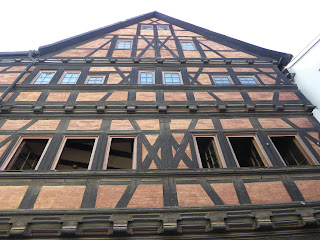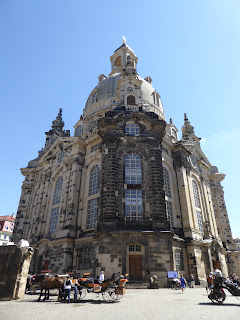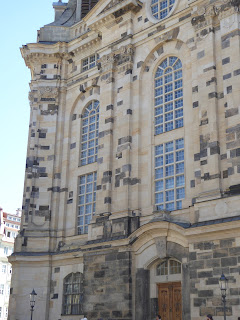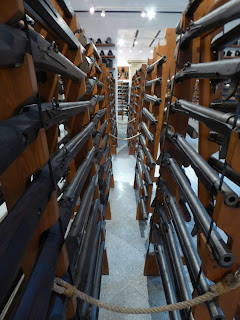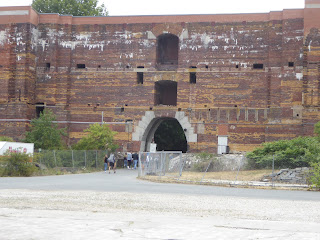We rode alone and not with a group as in the past, so we stopped where we wished, and our route was to Bruges-Cologne-Erfurt-Wittenberg-Dresden-Prague-Pilsen-Bingen-Kobern Gondorf-Bastogne-Mons-Calais and then home.
Here are a few pictures and words from the various places:
Cologne Cathedral
Rhine River, Cologne
The very pretty town of Erfurt, at the start of the Martin Luther trail:
St Mary's Cathedral, Erfurt
Continuing on the Luther trail to Wittenberg:
All Saints' Church, Wittenberg
Martin Luther tomb
The door with the Luther Theses
Originally nailed to a wooden door, now bronze
Initiated the break with Rome
A moment of reflection!
Dresden, largely destroyed by bombing in WWII with 25,000 deaths, now still being rebuilt:
Original, fire damaged, blocks have been used where possible
While part of East Germany, much was not rebuilt in the block communist style, so this has been a benefit. Great efforts have since been made to find original plans and to reconstruct buildings as they were. Even original stones and blocks have been identified from these plans and placed where they were originally.
En route to Prague, we stopped at Terezin, originally the old fort of Theresienstadt, which was turned into a ghetto and concentration camp for Jews by the Gestapo. About 150,000 prisoners went there, including 15,000 children, and 33,000 died from either malnutrition or mistreatment, some executions. About 88,000 were deported to Auschwitz or Treblinka extermination camps, and only 17,000 survived at the end of the War. The ghetto was prepared for a visit from the Red Cross, who were duped while hosted by the infamous Adolf Eichmann, during which only scripted answers were allowed from inmates and direction questions to them were ignored.
Onward to Prague and the 115th Rally. It was reported that 60,000 Harleys and 100,000 people had registered for the Rally. We could believe this because not only were the large parking areas of the Rally site crowded with bikes, but they were omnipresent around the city as well. The numbers would have represented a 10% increase on the population for those 4 days!
The Exhibition ground for the Rally was well suited - large and plenty of space and parking. There were many food and drinks outlets. As usual, there was an Expo of the current and historic models, a Custom Bike area, Harley and FMX stunt riding displays, a display of WWII military Harleys, other military equipment, stages with live rock music, a parade on Saturday that included 3,000 bikes over an 11km route through the city, and lots of opportunity to stock up on T-shirts!
The parade was great, as always, and we had prime position to watch on a bridge near our hotel as it passed by:
This Czech Chapter won the fancy dress!
Even a canine pillion, with own goggles!
We managed to meet up with Gunther & Debbie from Iceni Chapter, Norwich, whom I had been on the Sturgis trip with in 2012.
Some 'interesting' food choices!
Prague Castle was a must on our city tour and then we walked down from it across the Charles Bridge and into the Old Town, although to find the famous Astronomical Clock shrouded while being refurbished:
Charles Bridge:
At the top of the Astronomical Clock Tower:
In the Old Town Square:
The Memorial to students Jan Palach and Jan Zajic in Wenceslas Square, who self-immolated in protest of the Russian invasion of Czechoslovakia in 1969:
Onward to Pilsen, staying in a rather block shaped hotel on Republic Square and opposite St Bartholomew's Cathedral:
Nearby, a museum has one of the largest and oldest collections of blunderbusses and they are not small:
Pilsen Urquell Brewery, the first brewery to produce pale coloured lager:
Jean didn't like the traditionally produced and unfiltered beer! The kilometers of underground tunnels were quite cold at just 5degC too!
We got to know Republic Square better as we tried to leave Pilsen, some roads being closed around it, and some with one-way direction reversed. Navigation took us round it 5 times, over the cobbles and tram lines, far from enjoyable riding, in the heat and it seemed we might never break free!
In Nuremberg, we took in the Nazi Rally sites, then the Courthouse where the Nuremberg trials were held, although Room 600 was busy as it is still an operating court, so we couldn't look inside, but the exhibition was interesting.
Our guide Kevin, an American who has been there over the last 40+ years, was very knowledgeable and also entertaining as he told us of those days of the insane megalomaniac ambition of Hitler in building these huge, hardly used, sites at enormous cost in the few years that preceded the outbreak of WWII. He also had had pictures of how they were during use, which increased the impact.
Note the scale of the people foreground
The Colosseum-styled structure
was to be higher than this
and to only be used once a year!
The Courthouse
He gave conveyed how Hitler came to power as a great orator, persuading and indoctrinating the German people and organising them, complete with anecdotes and trivia about the senior personalities.
In the afternoon, we toured the medieval old town, which is both large and well preserved.
The Executioner's House on a bridge
because it was not allowed inside the city walls.
His place of work is left foreground
City Wall Gate
Tanners' street
Then we were off to Bingen am Rhein:
before heading for Kobern Gondorf on the Mosel:
Good beer was available throughout the trip!
In Bastogne, we visited the 101st Airborne Museum, the paratroopers who had held the city while under siege in the Battle of the Bulge in late 1944. General MaAulife famously responded "Nuts" when asked to surrender by the Germans. What we didn't realise was that that several squads of what could have been territorial Belgian troops marching down the road in front were about to enter it too!
Our hotel, close to the Museum, had certificates of appreciation from many tours of ex-WWII Americans who had visited Bastogne, a significant location in the military history.
Last of all, on the way to Mons, we visited the St Symphorien military cemetery.Now managed by the Commonwealth War Grave Commission, it is unique as it has slightly more (285) German soldiers than Commonwealth (229) dead, of whom 105 are unidentified. It also contains the graves of Commonwealth and German soldiers who died in the final days of the conflict, including George Ellison of the Royal Irish Lancers and George Price of the Canadian Infantry. Ellison and Price were killed on 11 November 1918, and are believed to be the last Commonwealth combat casualties of the war in Europe.






